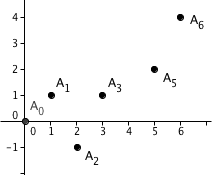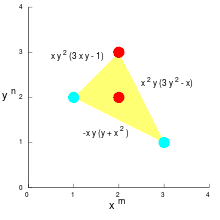Newton polygon

 .
.In mathematics, the Newton polygon is a tool for understanding the behaviour of polynomials over local fields.
In the original case, the local field of interest was the field of formal Laurent series in the indeterminate X, i.e. the field of fractions of the formal power series ring
- K[[X]],
over K, where K was the real number or complex number field. This is still of considerable utility with respect to Puiseux expansions. The Newton polygon is an effective device for understanding the leading terms
- aXr
of the power series expansion solutions to equations
- P(F(X)) = 0
where P is a polynomial with coefficients in K[X], the polynomial ring; that is, implicitly defined algebraic functions. The exponents r here are certain rational numbers, depending on the branch chosen; and the solutions themselves are power series in
- K[[Y]]
with Y = X1/d for a denominator d corresponding to the branch. The Newton polygon gives an effective, algorithmic approach to calculating d.
After the introduction of the p-adic numbers, it was shown that the Newton polygon is just as useful in questions of ramification for local fields, and hence in algebraic number theory. Newton polygons have also been useful in the study of elliptic curves.
Definition
A priori, given a polynomial over a field, the behaviour of the roots (assuming it has roots) will be unknown. Newton polygons provide one technique for the study of the behaviour of the roots.
Let  be a local field with discrete valuation
be a local field with discrete valuation  and let
and let
with  . Then the Newton polygon of
. Then the Newton polygon of  is defined to be the lower convex hull of the set of points
is defined to be the lower convex hull of the set of points
ignoring the points with  .
Restated geometrically, plot all of these points Pi on the xy-plane. Let's assume that the points indices increase from left to right (P0 is the leftmost point, Pn is the rightmost point). Then, starting at P0, draw a ray straight down parallel with the y-axis, and rotate this ray counter-clockwise until it hits the point Pk1 (not necessarily P1). Break the ray here. Now draw a second ray from Pk1 straight down parallel with the y-axis, and rotate this ray counter-clockwise until it hits the point Pk2. Continue until the process reaches the point Pn; the resulting polygon (containing the points P0, Pk1, Pk2, ..., Pkm, Pn) is the Newton polygon.
.
Restated geometrically, plot all of these points Pi on the xy-plane. Let's assume that the points indices increase from left to right (P0 is the leftmost point, Pn is the rightmost point). Then, starting at P0, draw a ray straight down parallel with the y-axis, and rotate this ray counter-clockwise until it hits the point Pk1 (not necessarily P1). Break the ray here. Now draw a second ray from Pk1 straight down parallel with the y-axis, and rotate this ray counter-clockwise until it hits the point Pk2. Continue until the process reaches the point Pn; the resulting polygon (containing the points P0, Pk1, Pk2, ..., Pkm, Pn) is the Newton polygon.
Another, perhaps more intuitive way to view this process is this : consider a rubber band surrounding all the points P0, ..., Pn. Stretch the band upwards, such that the band is stuck on its lower side by some of the points (the points act like nails, partially hammered into the xy plane). The vertices of the Newton polygon are exactly those points.
For a neat diagram of this see Ch6 §3 of "Local Fields" by JWS Cassels, LMS Student Texts 3, CUP 1986. It is on p99 of the 1986 paperback edition.
History
Newton polygons are named after Isaac Newton, who first described them and some of their uses in correspondence from the year 1676 addressed to Henry Oldenburg.[1]
Applications
A Newton Polygon is sometimes a special case of a Newton Polytope, and can be used to construct asymptotic solutions of two-variable polynomial equations like


Another application of the Newton polygon comes from the following result:
Let
be the slopes of the line segments of the Newton polygon of  (as defined above) arranged in increasing order, and let
(as defined above) arranged in increasing order, and let
be the corresponding lengths of the line segments projected onto the x-axis (i.e. if we have a line segment stretching between the points  and
and  then the length is
then the length is  ). Then for each integer
). Then for each integer  ,
,  has exactly
has exactly  roots with valuation
roots with valuation  .
.
Symmetric function explanation
In the context of a valuation, we are given certain information in the form of the valuations of elementary symmetric functions of the roots of a polynomial, and require information on the valuations of the actual roots, in an algebraic closure. This has aspects both of ramification theory and singularity theory. The valid inferences possible are to the valuations first of the power sums, by means of Newton's identities.
See also
References
- ↑ Egbert Brieskorn, Horst Knörrer (1986). Plane Algebraic Curves, pp. 370–383.
- Goss, David (1996), Basic structures of function field arithmetic, Ergebnisse der Mathematik und ihrer Grenzgebiete (3) [Results in Mathematics and Related Areas (3)] 35, Berlin, New York: Springer-Verlag, ISBN 978-3-540-61087-8, MR 1423131
- Gouvêa, Fernando: p-adic numbers: An introduction. Springer Verlag 1993. p. 199.
![f(x) = a_nx^n + \cdots + a_1x + a_0 \in K[x]](../I/m/6a3edbad8c76133f02429e3105bc9ab7.png)


